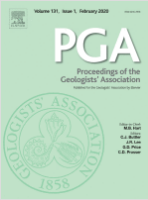“The Rhaetian (latest Triassic) succession of Doniford Bay, North Somerset has been noted as a site of fossils for over 200 years, and yet has never been described in detail despite its importance for palaeontology, for knowledge of a classic Triassic-to-Jurassic transition sequence, for structural geology, and as a venue for field trips. There are two bone beds, which differ substantially in sedimentary and palaeontological characteristics. Fossils include the usual teeth, denticles, and scales of small hybodont sharks, bony fishes, and marine reptiles. The lower (basal) bone bed is in many ways like those from other localities around Bristol and in South Wales, whereas the upper bone bed shows rich organic matter and an absence of calcite, suggesting a deeper location of deposition. Further, the lower bone bed contains abundant abraded silica grains, suggesting transport of sediment and bone debris from a beach or river. The two bone beds differ in faunal composition, and the upper bone bed lacks the locally derived clasts, larger silica grains, and calcite seen in the lower bone bed. Bones and teeth are equally abraded in both bone beds, confirming long-distance transport of fish and reptile fossils and that the upper bone bed cannot be interpreted as having derived from the lower.” read in PGA

